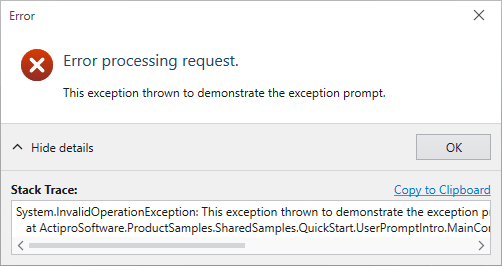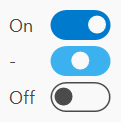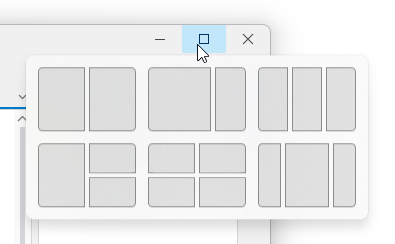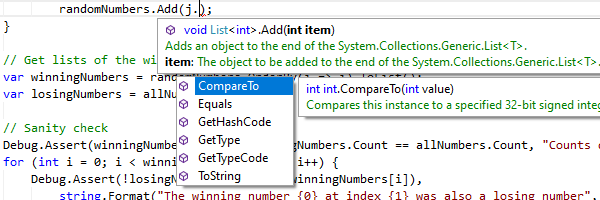This version includes many improvements for SyntaxEditor and its add-ons, along with updates to other UWP products.
See the related announcement post for the detailed list of enhancements and updates.

This version includes many improvements for SyntaxEditor and its add-ons, along with updates to other UWP products.
See the related announcement post for the detailed list of enhancements and updates.

This version includes new controls, new WindowChrome features for Windows 11, many improvements for SyntaxEditor and its add-ons, updates to nearly all WPF products, and now includes .NET 5 assemblies in the NuGet packages with validated .NET 6 compatibility.
See the related announcement post for the detailed list of enhancements and updates.
Here's a look at some of the new features.
Added a rich API that can create modern, themed dialogs for anything from simple messages and confirmations, to more advanced scenarios like exception notification dialogs or file copy dialogs.

We even include a ThemedMessageBox object with static methods that match the native WPF MessageBox API. Our themed version of the MessageBox uses a chromed WPF Window instead of Win32 dialogs (as the default WPF MessageBox does), along with fluent icons. This is important when your app is in a dark theme because it allows all message/confirmation dialogs to match the theme. You can instantly modernize all message box display in your app to our implementation with a single line of code too.
Added a new control that is often seen as a replacement for a traditional CheckBox in modern user interfaces.

It's easy to customize the appearance of ToggleSwitch to support other styles as well.
Made numerous updates to PopupButton to improve focus handling, tooltip display, key handling, and knowing when to close itself.
WindowChrome has added support for Windows 11 where it will use rounded corners and system-rendered drop shadows. In addition, hovering over the title bar's Maximize or Restore buttons will show the Windows 11 Snap Layout menu.

A new sample demonstrates synchronizing the scroller and splitter of one editor instance with another.
Improved drag/drop interaction and related scrolling in several scenarios, and add a new Drag and Drop QuickStart sample.
Added a formula example with alternate style for nested parentheses.

Made many small improvements in the areas of editing and caret movement, especially in certain special contexts.
Improved popups to reposition themselves as the editor is scrolled.

The vertical scrollbar has been updated to handle collapsed regions more smoothly.
Updated to support C# 8.0 syntax.
A new sample that demonstrates using an IResolver to navigate to the source of a reference.
The outliner will now create nodes for code-level constructs such as block statements by default.

Updated to support ECMAScript 2021 (12 Edition) syntax.
Added a constructor for whether the language should support JavaScript style comments, as in Microsoft’s JSONC variant.

Updated to support Python v3.9.5 syntax.
Updated to support namespace packages.
Added a FilterApplied event that is raised after the current filtering state has been applied to all of the control's items, generally occurring when DataFilter is changed, or filtering is enabled or disabled
Added a new item adapter method that can improve performance in large trees when searching for a tree node, and improved focus tracking and filtering.
Updated edit box commit triggers so that commit on focus loss is now optional.
Updated the numeric edit boxes to support input of Full-width and Arabic-Indic digits.
Added SignedMaximum and SignedMinimum aggregation options that compare against absolute values while retaining the sign of the original value; e.g., -5 is greater than 4.
The WPF Controls NuGet packages on nuget.org now contain compiled product assemblies that target:
Projects that target .NET 5 or later will use the .NET 5-based assemblies, and projects that target .NET Framework 4.5.2 or later will use the .NET Framework 4.5.2-based assemblies.
We’ve also validated that our assemblies work great in .NET 6 applications.

Our v2020.1 UWP controls have been updated with a new maintenance release that is now ready for download.
See this announcement post for the detailed list of enhancements and updates.

We are pleased to announce the release of the 2020.1 version of our UWP Controls.
This announcement post contains the detailed list of updates in the 2020.1 version. Please be aware that Windows 10 Fall Creators Update (version 1709) or later and usage of the Microsoft's free 'Win2D.uwp' NuGet package are required.
While the version includes a wide number of small updates and bug fixes, let’s take a look at a handful of the larger updates.
AutoCompleteBox now has a SelectedItemChanged event and an InputMode property, that alters input behavior. Search mode is the default and is intended for usage when the control is providing search-like functionality, commonly seen in application title bars. ComboBox mode is an alternate mode intended for use when the control should be used in more traditional ComboBox-like scenarios. When in ComboBox mode, the popup list filter turns off when not typing in the control, allowing the entire list to be browsed when interacting with the control purely via the popup.
BrushEditBox and ColorEditBox now have a HasText property that allows you to hide the text portion of the edit box for a swatch-only display.
DateEditBox and TimeEditBox now accept delimiter-less input for several additional custom formats.
Numeric edit boxes now support large incremental changes when holding Shift while pressing Up/Down or rotating the mouse wheel.
Several numeric edit boxes now support custom format strings with semi-colon conditional format specifiers.
We've added a PropertyGrid.RequestRefresh method that can be called to tell the PropertyGrid to refresh its contents.
A new background renders the search range when the search overlay pane is in Selection scope mode.
A new property allows you to disable key bindings that would activate the search overlay pane, which is useful if you have an external search UI.
Logic related the selection scope searching has been improved.
Ctrl+Enter can be pressed to execute a Find All search operation when the Find textbox has focus and the find all button is visible.
New methods allow completion list items to be added much faster, dramatically improving performance.
Our v2017.2 WPF, Universal Windows, and Silverlight controls have all been updated with new maintenance releases that are now ready for download. It is highly recommended that you get these new builds since many products received numerous minor enhancements and bug fixes.
Let's take a quick look at some of the more notable features that were added.
The mouse wheel can now scroll document tabs when in an overflow situation and using certain tab overflow behaviors.
Updated the color pickers such that the end user can tap and drag anywhere in a hue ring or saturation/brightness square to change color attributes, and not just on the thumb.
Added a new drop-down to ColorPicker that allows switching between RGB and HSB text input modes.
Added new features for adding custom inline UI elements within edit boxes, like the "Now" button in the TimeEditBox below.
Improved the DateEditBox and TimeEditBox default formats to better support parsing of entered text values that lack part delimiters.
Added the TreeListViewColumn.SortDirection property and related ColumnSortDirection enumeration that can be used to indicate that a sort glyph should appear in the column header when paired with a custom sorting mechanism.
Improved TreeListBox to better handle property updates from view-models on other threads.
Improved TreeListBox selection tracking performance.
Improved numerous edit actions to retain their final selection after the action goes through an undo/redo process.
Improved how Tab indenting is handled when there is a block selection.
Improved the Cut Line to Clipboard edit action to support multiple lines.
Improved the .NET Languages Add-on's logic for selecting the best IntelliPrompt parameter info member overload when typing a comma at the end of an argument list.
Improved the XML line commenter in the Web Languages Add-on to comment the entire line text when there is no selection.
There were also a large number of smaller improvements made throughout the products. See the announcement posts for the detailed list of enhancements and updates: